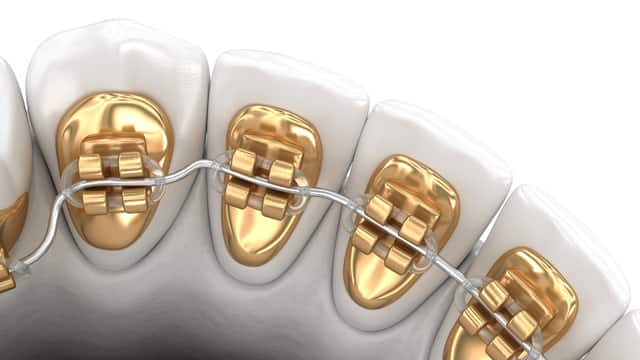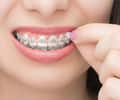Braces Overview
The technology and materials used in braces have continued to evolve, making them less bulky and visible than previously possible. Despite these advances, traditional braces have remained much the same in function.
Braces correct your bite, jaw, or tooth alignment issues. According to the American Dental Association, you may need braces because of injury, tooth loss, thumbsucking, or genetics.
Traditional braces are constructed out of several parts (brackets, bands, and wires) that apply gentle pressure on your teeth over time to reposition them. In traditional braces, brackets are fixed to your teeth and connected to an archwire. Your dental professional adjusts this archwire over time (typically every 6 weeks) to straighten your teeth through the orthodontic process.
Fun fact: You can customize the look of traditional braces made from any material with the various colors of elastics (also called ligatures) available.
Gold vs. Other Braces
Historically, many have been attracted to braces that provide the least noticeable look possible. Dental professionals typically accomplish this by using tooth-colored or clear materials or attaching the braces behind your teeth.
Some people would rather highlight their braces and make them a unique, dazzling part of their look. If this describes you, gold braces might be a great fit.
Gold braces differ from the classic, silver-colored braces in one simple way: the stainless-steel components are plated with gold. This creates a look where both the brackets fixed to your teeth and the wire attached to them are gold in appearance.
Orthodontic solutions that offer different looks include:
- Traditional, gold-plated braces
- Traditional, stainless steel braces
- Traditional, ceramic (tooth-colored) braces
- Lingual braces (attach behind the teeth)
- Mini-braces
- Clear aligners
Even though your appearance might be your biggest concern, consider that every orthodontic solution may not be the right choice for your situation. Other factors should also weigh into your decision as they can vary in cost, treatment time, and effectiveness. Ask your dental professional for their expert opinion on the best option for your individual needs.
What to Expect
Treatment times vary depending on your individual orthodontic needs and appliance, though on average, people wear braces for 1-3 years. It’s common to need a retainer after your braces are removed.
How much are gold braces? The cost of braces varies greatly based on your location, dental professional, treatment required, and the type of braces. According to the Cleveland Clinic, braces typically cost between $3,000-$6,000, if not more. Gold braces will generally cost more than stainless-steel counterparts due to the expenses from the gold plating and the gold itself.
Practicing proper oral hygiene is always important but is especially vital when you have braces. Maintaining healthy habits will help prevent tooth decay or damage to your braces.
Top tips for caring for gold braces:
- Avoid whitening products as they do not reach under your brackets, and your teeth could be a different color upon removal.
- Gently brush your teeth for two minutes twice a day using non-abrasive fluoride toothpaste.
- Use a flossing device once daily and consider using a floss threader.
- Don’t chew on non-food items like pens, pencils, or your nails.
- Consider skipping or limiting sticky, hard, or chewy foods.
- Visit your dental professional regularly.
Gold braces might be exactly what you were looking for if you need the treatment of classic braces but desire a bolder look. Be sure to practice a proper oral care routine and schedule regular visits with your dental professional to keep your braces in peak condition. You’ve made a great decision to acquire an in-depth understanding of orthodontics and gold braces.
Oral Care Center articles are reviewed by an oral health medical professional. This information is for educational purposes only. This content is not intended to be a substitute for professional medical advice, diagnosis or treatment. Always seek the advice of your dentist, physician or other qualified healthcare provider.
ORAL HEALTH QUIZ
What's behind your smile?
Take our Oral Health assessment to get the most from your oral care routine
ORAL HEALTH QUIZ
What's behind your smile?
Take our Oral Health assessment to get the most from your oral care routine
Join Us
Get the best of your oral health routine and take it to the next level with expert advice, recommendations, products and solutions and special offers.
Join Us
Get the best of your oral health routine and take it to the next level with expert advice, recommendations, products and solutions and special offers.















